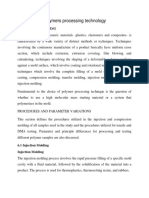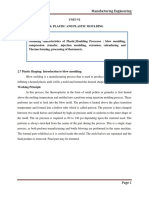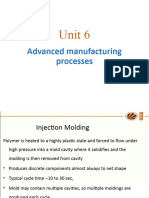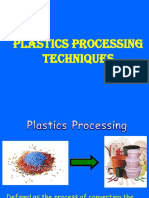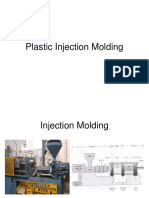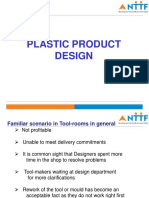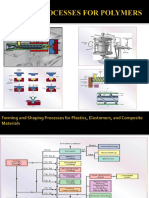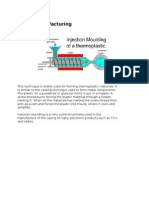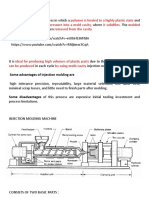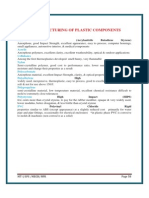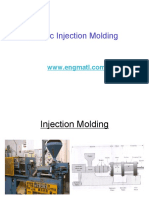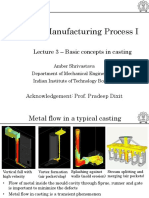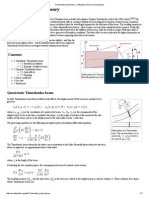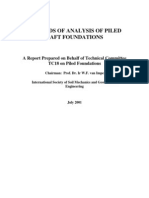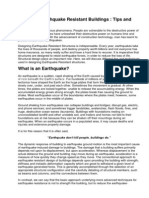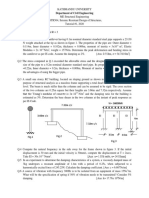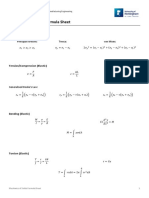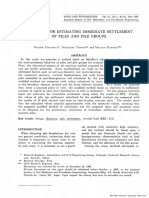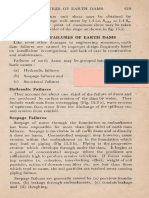ME206 – Manufacturing Process I
Lecture 15 – Polymer Processing
Amber Shrivastava
Department of Mechanical Engineering,
Indian Institute of Technology Bombay
Acknowledgement: Prof. Pradeep Dixit
1
� LEGO bricks – injection molding
https://www.youtube.com/watch?v=C3oiy9eekzk
2
� Properties of polymer melts
• Viscosity is a fluid property that relates the shear stress (𝜏) experienced during
flow of the fluid to the rate of shear (𝛾)
• For a polymer melt, viscosity decreases with shear rate,
– The polymer fluid becomes thinner at higher rates of shear.
– This behavior is called ‘Pseudoplasticity’
– For normal Newtonian fluid (water, oil), 𝑛 = 1
– For molten polymer , 𝑛 < 1
• Viscosity reduces with increasing temperature
𝜏 = 𝑘𝛾𝑛
𝑛 < 1
𝑛 =1
3
� Properties of polymer melts : Viscoelasticity
𝐷𝑥
𝑆𝑤𝑒𝑙𝑙 𝑟𝑎𝑡𝑖𝑜 =
𝐷𝑑
Dx = diameter of the extruded cross section
Dd = diameter of the die
• Die swell in extrusion: Hot plastic expands when exiting the die opening.
• Extruded material ‘‘remembers’’ its former shape and attempts to return to it after
leaving the die orifice.
• Compressive stresses acting on the material as it enters the small die opening do
not relax immediately. When the material subsequently exits the orifice and the
restriction is removed, the unrelaxed stresses cause the cross section to expand.
• Amount of die swell depends on the time the polymer melt spends in the die
channel.
• Increasing the time in the channel, by means of a longer channel, reduces die swell.
4
� Injection molding - Animation
https://www.youtube.com/watch?v=b1U9W4iNDiQ
5
� Automotive Parts made by injection molding
• Exterior components: including fenders, grilles, bumpers, door panels, floor rails,
light housings and more.
• Interior components: instrumentation components, interior surfaces, dashboard
faceplates, door handles, glove compartments, air vents and more
• Materials : Acrylonitrile butadiene styrene (ABS), Polyamide (PA), Polypropylene
(PP), Poly(methyl methacrylate) (PMMA), Reinforced composites
6
� Injection molding
• Similar to die-casting machine
• Plastic injection unit and mold clamping units
• Heating elements are critical to convert plastic raw granules into molten state
• Die/punch kind of arrangement in clamping unit
https://www.youtube.com/watch?v=a8HQG2PUPik 7
� Typical molding cycle
Typical molding cycle: (1) mold is closed, (2) melt is injected into cavity, (3) screw is retracted,
and (4) mold opens, and part is ejected.
8
� Two-plate mold for thermoplastic injection molding
Details of a two-plate mold for thermoplastic injection molding:
(a) closed and (b) open.
• Mold has two cavities to produce two cup-shaped parts with each injection shot.
• Mold have distribution channels consisting sprue, , runners and gates (multiple)
9
� Shrinkage in injection molding
• Polymers have high thermal expansion coefficients,
and significant shrinkage occur during cooling of the
plastic in the mold
• To compensate for shrinkage, the dimensions of the
mold cavity must be made larger than the specified
part dimensions
• 𝐷𝑐 = 𝐷𝑝 + 𝐷𝑝𝑆 + 𝐷𝑝𝑆2
– Dc: dimension of cavity (mm);
– Dp: molded part dimension (mm),
– S: shrinkage values
• Because of differences in shrinkage among plastics,
mold dimensions must be determined for the
particular polymer to be molded.
– The same mold will produce different part sizes
for different polymers
10
� Defects in injection molding
• Short shots: As in casting, a short shot is a molding that has solidified before
completely filling the cavity.
– Can be corrected by increasing temperature and/or pressure.
• Flashing: When the polymer melt is squeezed into the parting surface
between mold plates or around ejection pins.
– Usually caused by (1) vents and clearances in the mold that are too large;
(2) injection pressure too high compared with clamping force; (3) melt
temperature too high; or (4) excessive shot size.
• Sink marks: Defects usually related to thick molded sections.
– A sink mark occurs when the outer surface on the molding solidifies, but
contraction of the internal material causes the skin to be depressed below
its intended profile.
11
� Compression and Transfer molding
(1) charge is loaded; (2) and (3) charge is compressed and cured; and (4) part
is ejected and removed
• Compression molding for thermosetting plastics. Used for rubber tyres
12
� Pot transfer molding
• The charge is injected from a ‘‘pot’’ through a vertical sprue channel into the cavity;
13
� Plunger transfer molding
(1) Charge is loaded into pot, (2) softened polymer is pressed into mold
cavity and cured, and (3) part is ejected
• The charge is injected by means of a plunger from a heated well through lateral
channels into the mold cavity
• Transfer molding is capable of molding part shapes that are more intricate than
compression molding but not as intricate as injection molding.
14
� Pressure thermoforming
• Thermoforming is a process in which a flat thermoplastic sheet is heated and
deformed into the desired shape.
• The process is widely used in packaging of consumer products and fabricating
large items such as bathtubs, contoured skylights, and internal door liners for
refrigerators.
• Methods by which forming is accomplished can be classified into 3 categories:
(1) vacuum thermoforming, (2) pressure thermoforming, and (3) mechanical
thermoforming.
15
�Vacuum thermoforming : Positive mold shape
(1) the heated plastic sheet is
positioned above the convex
mold and (2) the clamp is
lowered into position,
draping the sheet over the mold
as a vacuum forces the sheet
against the mold surface.
Pre-stretching the sheet
in prior to draping and
vacuuming it over a
positive mold in (2).
16
�Mechanical thermoforming
17
� Design considerations
• Strength and stiffness: Plastics are not as strong or stiff as metals.
– Should not be used where high stresses are encountered.
– Creep resistance is also a limitation.
– Strength properties vary significantly among plastics,
– Strength to-weight ratios for some plastics are competitive with metals in
certain applications.
• Impact resistance: Capacity of plastics to absorb impact is generally good;
– Plastics compare favorably with most metals.
• Operational temperature ranges of plastics are limited relative to engineering
metals and ceramics.
• Thermal expansion is greater for plastics than metals
– Dimensional changes owing to temperature variations are more significant
than for metals
18
� Design guidelines for injection molding
• Economic production quantities:
– Each molded part requires a unique mold,
– Minimum production quantities for injection molding are usually around
10,000 pieces;
• Corner radii and fillets:
– Sharp corners, both external and internal, are undesirable in molded parts
– They interrupt smooth flow of the melt, tend to create surface defects, and
cause stress concentrations in the finished part.
• Wall thickness:
– Thick cross sections are generally undesirable
– more likely to cause warping caused by shrinkage and take longer to harden
19
� Design guidelines for injection molding
• Holes:
– Holes are quite feasible in plastic moldings, but they complicate mold
design and part removal. Also cause interruptions in melt flow.
• Draft:
– A molded part should be designed with a draft on its sides to facilitate
removal from the mold.
– Especially important on the inside wall of a cup shaped part because the
molded plastic contracts against the positive mold shape.
– Recommended draft for thermosets is around 0.5 to 1,
– For thermoplastics it usually ranges between 0.25 and 0.5.
• Tolerances:
– Tolerances specify the allowable manufacturing variations for a part.
– Generous tolerances are desirable for injection moldings because of
variations in process parameters that affect shrinkage.
20





